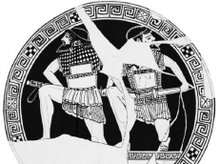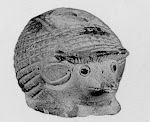Those who support a literal interpretation of the othismos as a pushing match have pointed out that the hollow design of the shield allows the left shoulder to be placed within it both to support the weight of the shield and to allow for a sideways pushing stance, while the flattened face provides a broad surface for pushing against the men in front of you. While correct in some details, this scheme fails when we apply a realistic model of othismos mechanics.
John Keegan, in The Face of Battle, noted that a crowd is the opposite of an army when he applied crowd psychology to formed men, and that crowd-like behavior signaled immanent defeat, but the ancient Greeks harnessed the force of a panicked crowd and turned it into an offensive weapon. The modeling of how force is generated in crowds is in its infancy, but the destructive potential is shown by the many tragic deaths caused by crowds colliding during sports events or fleeing in panic.
The outcome of a collision of ranked hoplites is not simply a matter of the number of men on either side. Most of the force applied by the rear ranks will be simply absorbed by the mass of their own men in front of them. In order to maximize the pushing force of a crowd, the distance between bodies must be minimized to the point that individuals lose control of their own movement and the group becomes one mass pushing in synchrony. In crowds of this density, shock waves are produced that can tear off clothing, lift people off their feet, and propel them 3 m or more through the air. These forces are generated by a domino effect of people leaning against each other and pushing in the same direction at once, and have been shown to exceed 1000 lbs of force and bend metal retaining structures. Death occurs in these conditions due to compressive asphyxia when the diaphragm is crushed and breathing is impossible.
Men must protect against asphyxiation if they are to subject themselves to these forces for the duration of battle. This is the aspis’ primary function and a role for which it is uniquely designed. The shield’s large diameter arose from the need to hold the shield across the front of the body, its flat rim resting on the upper chest and thighs, while the depth protected the diaphragm and allowed the hoplite to draw breath. The central position of the porpax ensured proper alignment, but left about a third of the shield extending beyond the hoplite to the left. As individuals with their shields tight to their chest came up behind the overhanging shields of men to their right, overlapping right over left, a phalanx assembled like building blocks. The job of rear rank veterans, who could push with their shoulders, was not simply to keep men from fleeing battle, but to keep them packed belly to back and as tightly as possible. The lethal zone in a crowd of this density extended well back into the phalanx, so the risk of death by asphyxiation was shared more equally among ranks than the danger from weapon strikes.
Along with the characteristic aspis, a second element of the panoply associated with the emergence of hoplites is the sauroter, a specialized butt-spike for the spear. The sauroter has been linked to phalanx combat through its use as an auxillary weapon, but this role was secondary to its use as a staff in steadying a man in the rear ranks and allowing him to add the strength of his right arm in pushing.
Weapons could still be used in the press of othismos, as the raised right arm would have just enough room to brandish a weapon in an overhand strike in the “V” formed by overlapped shields. The downward stabbing strike of a spear would require very little range of motion to be deadly, while the point-heavy chopping swords commonly used relied on a snap of the wrist more than a broad slash. The most deadly weapon in this press would be the short Laconian dagger stabbing in a downward strike from above. If the othismos gradually became the phase of battle that decided hoplite battles, this may explain the abandonment of body armor and enclosed helms for the high-peaked pilos that protected from overhead strikes. Any benefit of armor in the crowd would be outweighed by the need for increased stamina and the ability to breathe freely and hear commands.
That the Spartans developed a specialized weapon for the othismos is perhaps indicative of their role in perfecting this phase of combat. We are told that the Spartans did not excel in combat because of the martial arts teaching of hoplomachoi, but because of their singing and dancing. The reason for this is obvious if we accept the model presented above. Accidental synchronicity of effort is what builds lethal shock waves in crowds, so men who have trained to coordinate their motions through group dancing and rhythmically chanted songs will have an advantage in producing and amplifying forces in the othismos. Theban success in battle was explained in part by their skill in wrestling which develops kinesthetic sense and ability to read and anticipate motions.
Thebes met Sparta in battle again at Leuktra in 371 B.C. in the ultimate othismos battle. In an outcome presaged by Koronea, the Thebans countered Spartan skill with mass. The 12 ranks of Sparta collided with 50 ranks of Theban hoplites, who had added Boetian merchants and baggage-carriers to the rear of the phalanx. Our model of othismos helps us understand what happened next. The deep Theban formation did not crash into the Spartans and immediately drive it from the field. What followed was an almost tidal play of crowd against crowd. The synchronized Spartans could push back the Thebans, as they did to claim their wounded King, but each time they did this they packed them tighter, forcing them into a coordination that they may not have achieved on their own. There may have been long lulls where exhausted men simply fought for breath in the loosening crowds. Epaminondas’ called-for “one more step” was in reality a shuffle, but the Thebans eventually gained ground in a ratcheting advance that broke the Spartan ranks and their hegemony.
The othismos turned a phalanx into more than sum of its ranked hoplites. To fight within such a crowd was to submerge one’s individuality, and facing one was like standing against single scale-breasted beast, a many-headed hydra of down-thrusting weapons. Perhaps it is fitting that the states who mastered it were both descended from Heracles.
Paul M. Bardunias is not a historian, but an entomologist who studies group behavior in social insects- termites and ants. On the theory that one Myrmidon is as good as another, he is applying concepts from his background in biology and crowd behavior to an examination of the evolution of Greek weapons and tactics. He was born to the topic, his family comes from Sparta, but this is his first publication specifically on Greek warfare. He lives and works in Hollywood, Florida, USA.
Further reading:
J. Fruin, The Causes and Prevention of Crowd Disasters, in: R. A. Smith, J. F. Dickie (Eds.), Engineering for Crowd Safety. Elsevier, New York, 1993.
A. K. Goldsworthy, The Othismos, Myths and Heresies: The Nature of Hoplite Battle. War in History 4: 1, 1-26, 1997.
V. D. Hanson, The Western Way of War: Infantry battle in Classical Greece. New York, Hodder & Stoughton, 1989.
J. Keegan, The Face of Battle. London, Cape, 1976.
R. D. Luginbill, Othismos: The Importance of Mass-Shove in Hoplite Warfare. Phoenix, 48:1, 51-61, 1994.
N. Secunda, Greek Hoplite 480-323 BC. Osprey Publishing Ltd., 2000.
A. Snodgrass, Early Greek Armour and Weapons. Edinburgh University Press, 1964.
Friday, October 17, 2008
Subscribe to:
Post Comments (Atom)





2 comments:
Brilliant. Going to crowd disasters for information was simply brilliant. I'm a mere history nut and wargamer, but I've always been conscious that there was some real gap in my understanding of how things worked at the sharp end of a phalanx (or a cohort, for that matter). Among other things, I could not resolve how certain battles involved massive casualties on one side and almost none on another through any other model I had thought of. Your proposal offers such a good solution that I have to skip all the usual qualifiers and just say, "This has to be it".
Thanks, I could not ask for a better reception of my ideas. I agree that once you understand it it seems obvious that this is what occurred. Getting people to the initial understanding is a challenge because we generally have little experience with crowds such as this and much of the mechanics are counterintuitive.
Post a Comment